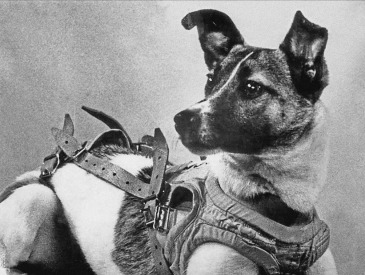Laika: The First Living Creature in Space
Discover the incredible and tragic story of Laika, the first living creature to orbit Earth. Learn how this stray dog became a space pioneer and explore her lasting legacy in space exploration.
NEWS
2/10/20252 min read


Laika – The First Dog in Space
On November 3, 1957, a small stray dog named Laika made history by becoming the first living creature to orbit Earth. Her journey aboard Sputnik 2 was a groundbreaking moment in the Space Race, proving that a living being could survive in space—at least for a short time. But behind the scientific triumph was a tragic and controversial story of sacrifice. Laika never returned to Earth, making her one of the most well-known martyrs of space exploration.
A Stray Dog Chosen for Space
Laika was a mixed-breed stray found wandering the streets of Moscow. Soviet scientists believed that stray dogs, having endured harsh conditions, would be better suited to withstand the extreme stresses of space travel. Laika was selected along with several other dogs for training, and her calm temperament and small size made her the final choice for the mission.
Scientists prepared Laika by exposing her to simulated launch conditions, such as being confined in small spaces, experiencing extreme acceleration, and wearing a specially designed pressurized suit. She was placed in progressively smaller cages to prepare her for the cramped interior of Sputnik 2, a spacecraft that had no plans for re-entry.
The Launch of Sputnik 2
On November 3, 1957, Laika was strapped into her tiny capsule aboard Sputnik 2 and launched into orbit. For a few brief hours, she became the first animal to orbit Earth, proving that a living creature could survive in space long enough to enter orbit. Soviet officials claimed that Laika survived for several days before passing away peacefully. However, decades later, it was revealed that Laika died within hours of launch due to extreme heat and stress caused by a malfunction in the thermal control system.
At the time, Soviet scientists had no way to bring Laika back safely. The mission was never intended to be a return flight, a fact that remains one of the most controversial and debated aspects of her journey.
Laika’s Legacy
Although her story is tragic, Laika’s mission provided invaluable data that helped pave the way for human spaceflight. The information gathered from her flight helped the Soviet Union prepare for Yuri Gagarin’s historic journey in 1961, making him the first human to travel into space.
In the years following her mission, Laika became a symbol of sacrifice and progress in space exploration. She has been honored with:
Monuments and memorials, including a statue near Moscow’s space research facility
Commemorative stamps issued in Russia and beyond
References in books, movies, and music, keeping her story alive
Her sacrifice also led to better treatment of animals in space research, influencing later missions to focus on returning animals safely to Earth.
Watch Laika’s Story
For those who want to see more about Laika’s historic mission, here’s a documentary that tells the full story:
Final Thoughts
Laika’s journey represents both scientific progress and ethical questions about how animals have been used in research. While she never returned, her contribution to space exploration was monumental. She remains one of the most famous dogs in history, remembered not just as a test subject, but as a pioneer who paved the way for space travel.
Would you like to move on to the next breed-specific article, or do you have another famous dog in mind for the next historical feature?

